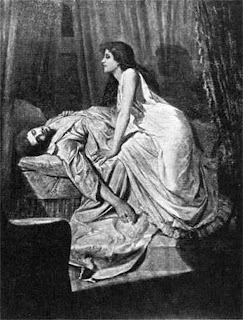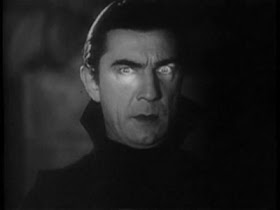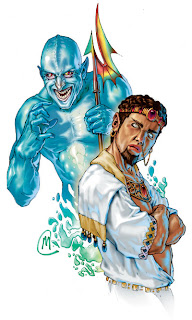A mermaid is a legendary aquatic creature with the upper body of a woman and the tail of a fish.Mermaids appear in the folklore of many cultures worldwide, including the Near East, Europe, China, and India. The first stories appeared in ancient Assyria, in which the goddess Atargatis transforms herself into a mermaid out of shame for accidentally killing her human lover. Mermaids are sometimes depicted as perilous creatures associated with floods, storms, shipwrecks, and drowning. In other folk traditions (or sometimes within the same tradition) they can be benevolent, bestowing boons or falling in love with humans.

Mermaids are associated with the Sirens of Greek mythology and with the Sirenia, a biological order which comprises dugongs and manatees. Historical sightings by sailors may have been the result of misunderstood encounters with these aquatic mammals. Christopher Columbus reported seeing mermaids while exploring the Caribbean, and sightings have been reported in the 20th and 21st centuries in Canada, Israel, and Zimbabwe. The US National Ocean Service stated in 2012 that no evidence of mermaids has ever been found.
Mermaids have been a popular subject of art and literature in recent centuries. Danish author Hans Christian Andersen wrote his popular fairy tale "The Little Mermaid" in 1836. They have subsequently been depicted in opera, paintings, books, films, and comics.
Sightings
In 1493 while sailing off the coast of Hispaniola, Christopher Columbus reported seeing three "female forms" which "rose high out of the sea, but were not as beautiful as they are represented". The logbook of Blackbeard, an English pirate, records that he instructed his crew on several voyages to steer away from charted waters which he called "enchanted" for fear of merfolk or mermaids, which Blackbeard and members of his crew reported seeing. These sighting were often recounted and shared by sailors and pirates who believed that mermaids were bad luck and would bewitch them into giving up their gold and dragging them to the bottom of the sea. Two sightings were reported in Canada near Vancouver and Victoria—one from sometime between 1870 and 1890, the other from 1967.
In August 2009, after dozens of people reported seeing a mermaid leaping out of the water and doing aerial tricks, the Israeli coastal town of Kiryat Yam offered a $1 million award for proof of the mermaid. The Mermaid Medical Association, an American mermaid advocacy group, threatened to take legal action against the town in response to their offer, which "badly and outrageously damages the legendary mermaid legacy." In February 2012, work on two reservoirs near Gokwe and Mutare in Zimbabwe stopped when workers refused to continue, stating that mermaids had hounded them away from the sites. It was reported by Samuel Sipepa Nkomo, the water resources minister.
Hoaxes
In the middle of the 17th century, John Tradescant the elder created a wunderkammer (called Tradescant's Ark) in which he displayed, among other things, a "mermaid's hand". In the 19th century, P. T. Barnum displayed a taxidermal hoax called the Fiji mermaid in his museum. Others have perpetrated similar hoaxes, which are usually papier-mâché fabrications or parts of deceased creatures, usually monkeys and fish, stitched together for the appearance of a grotesque mermaid. In the wake of the 2004 tsunami, pictures of Fiji "mermaids" circulated on the Internet as supposed examples of items that had washed up amid the devastation, though they were no more real than Barnum's exhibit.
Facts
Scientists do not think it’s possible for a creature to exist that is half mammal and half fish, the two species are simply too far apart in terms of vertebrate’s evolution. The popular scientific theory is that manatees or sea cows are what some sailors have seen and, due to long voyages at sea and malnutrition, have mistaken them for human-like creatures. The manatees are found in coastal regions and have a fish-like tail, but they could never be described as having a comely face.
Even though we know very little about our oceans, with such a tiny portion of it explored; scientists still believe it unlikely mermaids are creatures yet to be discovered. They agree that there are many animals that we don’t know about yet and sometimes creatures are discovered; like the Coelacanth, ("see-la-kanth"), that 400 million year old "living fossil" fish, pre-dating the dinosaurs by millions of years and once thought to have gone extinct with them, 65 million years ago, the Coelacanth with its "missing link" "proto legs" was "discovered" alive and well in 1938 at the mouth of the Chalumna River on the east coast of South Africa. But the truth is, say the scientists, that the deep-sea areas have only become inhabited fairly recently in geological terms; so the likelihood of anything popping up from mythology is pretty low.
So does this mean that the mermaids of myth and legend have never existed? Some argue that there is a link between the Sirens of Homer’s Odyssey and mythological mermaids; the only problem with this is that the Mediterranean Sea, where the Odyssey is set, completely dried up around 10 million years ago and only started to refill recently during the times of mankind. In early Homer references the sea was as dry as a desert. This means that ancient Western stories from the Mediterranean cannot have creatures of this kind in them brought over from ancient times. But the interesting thing about mermaids is that stories about them come from all over the world, from different countries and cultures; as if they are part of the human collective memory. In West Africa, Mami Wata is a Vodou goddess of the sea who appears in mermaid shape; she is kind to women and often blesses them with children, but has special sympathies for barren women.

The Babylonian God Oannes is said to be the first recorded creature part man, part fish; Lord of the Waters.
There have been links with human women and mermaids for a long time; the pain a mermaid goes through when she wishes to become human has been compared to the pain of menstruation and childbirth. Inthe Hans Christian Anderson story, The Little Mermaid, she has to bear the pain of 8 oysters being attached to her tail at the age of 15 to denote her rank, that she has come of age. Later when the witch grants her wish to become human, she has to bear the terrible pain of her tail splitting in two, becoming legs, with every following step feeling like walking on needles and swords. The tail here seems to be symbolic of the female reproductive system. In Melusine the French Medieval tale, Melusine married Raymond of Poitou, she forbid him to see her in the bath one day out of the week. They had children, and some of them had strange features like big teeth. One day he spied on her in the bath, and saw that she was part serpent or fish. This is thought to parallel men’s feelings of being unable to affect the changes women go through, particularly their menstrual cycle. Stories like these may back up what the scientists say, that mermaids do not exist, they could merely be a way of expressing certain human conditions in stories.
Still others argue that we should not discount the similarities of world-spanning mermaid sightings and myths, pervading so many different cultures who express aspects of life in vastly different ways. Mermaids are said to have fairy-like powers, with the ability to grant wishes; some fisherman have believed that spotting a mermaid is a bad omen, yet spotting them has saved their lives by making them steer clear of their intended paths. It could easily be argued, and well believed, that if something can exist with such prominence in the human psyche, the chances are that it is real; mermaids either exist here on Earth and appear when they wish, or live in some other dimension or plain of existence that our collective consciousness remembers.
How did the myths about mermaids arise?
Legends of half-human, half-fish creatures go back thousands of years. Everyone has seen pictures of mermaids. Sightings were made by the early Arabs and the Greek Pliny in 586 A.D. Many medieval sailors claimed to have seen them and such reports continued right into the 1900's.
Most sightings by sailors were probably normal marine creatures, such as manatees, dugongs, or sea-cows (now extinct). These appear to cradle their young much as a human would carry a baby. It is possible that sailors, seeing these unfamiliar beasts, would assume that they had stumbled across some sort of humanoid species. Mermaids described by the famous explorer, Christopher Columbus, were almost certainly manatees. He reported seeing three mermaids in the ocean off Haiti, in January of 1493. He said they "came quite high out of the water", but were "not as pretty as they are depicted, for somehow in the face they look like men."
However such descriptions are very different from the usual portrayal of a mermaid and the idea, of a beautiful but dangerous creature, probably arose from the earlier stories of the Sirens of the Aegean Sea. The Sirens were sea-nymphs who had the power to charm by their song all who heard them, so that the unhappy mariners were irresistibly impelled to cast themselves into the sea to their destruction. The Sirens were first mentioned in Homer's Odyssey. This may have shaped the portrayal of mermaids from medieval times onwards. The modern view of mermaids has also been influenced by Hans Christian Andersen's fairytale, The Little Mermaid, written in 1836.
So, are mermaids good or bad?
It seems it would depend on which story you read. However, based on the evidence, you would need to be very careful if you ever encountered one.
In British folklore they can be bringers of bad fortune, capable of causing storms and killing humans.Some of the bad things that mermaids are accused of include telling sailors their ship is doomed and enchanting sailors
and causing shipwrecks. Seeing a mermaid is a sure sign of a violent storm to come. In other stories, they deliberately drag people down in the water and squeeze the life out of drowning men. They also take men down to their underwater kingdoms.
However, on occasions, mermaids can also bring good fortune by giving humans cures or granting them wishes. In some tales, they even marry and live with humans. For example, the Merrow of Ireland and Scotland.
These mermaids are beautiful, gentle, modest and kind. They wear a red cap and, if this is captured and hidden from them, they will shed their skins and stay on land. However, most times they eventually retrieve the cap and return to the sea. They also lure young men to follow them beneath the waves. Here they live in an enchanted state. Merrow music is often heard coming from beneath the waves.
How did this story come about?
The Lizard in Cornwall is a high plateau surrounded by the sea, with numerous hidden little coves and beaches, just the sort of area for mermaid stories.
Many Cornish people, particularly sailors, have claimed to have seen or heard a mermaid and belief in them was once widespread. There are many stories of mermaids seen on the rocks and of mermaids sitting weeping and wailing on the shore.
The mermaids in Cornish stories possess many of the features of mermaids the world over. They are beautiful, often seen combing their golden hair and live for a long time without ageing. Like many British and Irish mermaids, the mermaid in this story has more sympathy, inquisitiveness and interest in humans than other mermaids.
It was often thought that people with a knowledge of healing or a knowledge of the future gained these powers by supernatural means, either from the witches, fairies or, in this case, a mermaid. This is not the only tale passed down the generations, of special powers given to an ancestor from a mermaid. Preparing a vessel of water, which would show the face of a thief, as in the story, is a common means of detection that occurs in many myths.
Mermaids are one of the most famous mythical creatures, depicted regularly in literature and film. The "Mermaid's Rock" can still be seen off the coast and you can visit Kynance cove and the beaches by the Lizard.









































